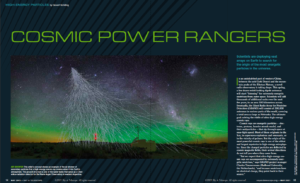Nikhef-onderzoekers Sijbrand de Jong en Charles Timmermans worden door Govert Schilling geïnterviewd voor een artikel in Sky & Telescope over o.a. Pierre Auger Observatory in Argentinië.
Scientists are deploying vast arrays on Earth to search for the origin of the most energetic particles in the universe.
In an uninhabited part of western China, between the arid Gobi Desert and the mountain peaks of the Tibetan Plateau, a novel radio observatory is taking shape. This spring, a few dozen weird-looking dipole antennas will start “listening” for extremely energetic neutrinos from outer space. Scientists will add thousands of additional units over the next five years, in an area 100 kilometers across. Eventually, the Giant Radio Array for Neutrino Detection (GRAND) will consist of 200,000 antennas in various parts of the world, covering a total area as large as Nebraska. The ultimate goal: solving the riddle of ultra-high-energy cosmic rays.
Cosmic rays are energetic particles — electrons, protons, heavier atomic nuclei, and their antiparticles — that zip through space at near-light speed. Most of them originate in the Sun, in supernova explosions and remnants, or in the vicinity of pulsars. But the origin of the most powerful cosmic rays is one of the oldest and largest mysteries in high-energy astrophysics.
Since the charged particles are deflected by cosmic magnetic fields, their arrival directions do not tell you where they came from. “But we expect that ultra-high-energy cosmic rays are accompanied by extremely energetic neutrinos,” says GRAND project manager Charles Timmermans (Radboud University, the Netherlands), “and because neutrinos have no electrical charge, they point back to their source.
Lees het artikel in Sky & Telescope (English only).
